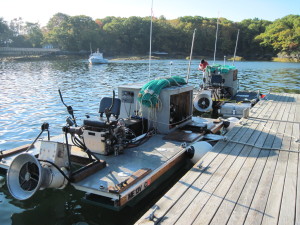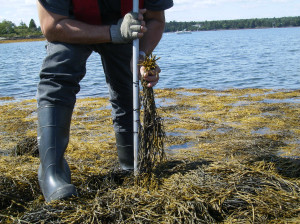Rockweed harvesting techniques have improved over the years, similar to farming and other agricultural industries. The need for efficient means of gathering resource is driven by both economy and sustainability. A mechanical harvester is a tool, like any other tool, designed to perform a task. This task is to gather Rockweed. Like using a pneumatic nail gun instead of a hammer to frame a house today, some use mechanical harvesters instead of rakes and knives. Precision, accuracy and efficiency play key roles in these vessels. Rockweed grows in the intertidal zone, the area between the low water mark and the high water mark. It does not grow in mud, sand or other loose substrates well. However, it does thrive on rocks! A harvesting boat floats up to and
over the rocks while cutting the rockweed to a predetermined cut height, keeping the holdfast intact to allow the plant to regenerate, and nets it up for pickup and transport.
How a Mechanical Harvester Works
First, the basics; there are several mechanical harvesting boats along the coast, all appearing different in shape, size and general presentation. The general operation, however, is similar. There is a cutting “head” and a nozzle to move cut rockweed to a “hopper”, or “net”. By explaining how they work it should become clear why mechanical harvesting is more sustainable than other means.
Let’s get to how harvesters work. Basically there are three major functions of the craft: cutting, netting, and propulsion. The boats I’m most familiar with use a tube running from front to back of the vessel. In the front of the tube is a rotary cutting head that, as its name infers, cuts the rockweed. It is set with a collar around the cutter that keeps foreign material out and sets cutting height. (As a side note, the physical size of the collar prohibits it from reaching areas between the rocks, leaving rockweed in those areas untouched.) It cannot reach any deeper than the highest rock in the bed.
The cutter head only spins about 300 rpm+/-. It does not need to spin fast, as cut rockweed evacuation is done via a flow of water over the cutter head (this is important in the understanding that, unlike a lawn mower, the cutter head does not use the speed of its blades to “throw” cut material aside). This action occurs thanks to another device downstream of the cutter head called a velocitator, which is merely a propeller mounted a few feet inboard in the tube creating flow/suction over the cutterhead. This flow moves the cut rockweed from the cutter head into the nets where it is captured. The nets are an open mesh, allowing water and small organisms to flow through them, but capturing the cut rockweed.
The third important, and obvious function of the mechanical harvester boat is propulsion. The propeller on these boats is installed inside a tube, providing protection of the propeller and whatever may come in contact with it. The propeller is a few feet inside the tube to lessen the ability of rockweed becoming entangled and pulling the weed off the rocks, as well as to keep the boat mobile without fouling.
Sustainability of Mechanical Harvesting
Now let’s speak to the sustainable harvesting of rockweed by looking at what harvesters do and don’t do. Harvesters are first and foremost concerned about the health of the plant that is harvested. The holdfast is basically the root of the plant. Like your lawn at home, if you pull the grass out by the roots, suddenly you have no lawn, whereas if you cut off the top, you still have a lawn to mow later. If the root, or holdfast is removed, then the plant is gone and time will have to pass for a new one to grow in its place.
With a more automated system it becomes increasingly hard to remove not only the holdfast, but too much of the plant in the first place. Again, I liken it to your lawn at home. You can send your 15 year old out with the mower and while they may be standing there texting their buddies with the mower running away in one patch, when they finally start pushing again, that grass is still the same height. Unlike a sharpened rake that relies on the skill and conscience of the person using it, the mechanical harvester is equipped with guards, cutting height stops, and terrain limitations that squelch the possibility of cutting too short. (As a side note, 16″ is minimum cutting height for rockweeds of the coast of Maine. Other countries have different, typically shorter, limits.)
Cutting rockweed is what these machines do. They do not suck the weed off the rocks. If the cutter head fails, there will be no rockweed removed from the rocks. There simply is not enough suction from the velocitator to pull the weed off. Both the cutter head and the velocitator need to work in harmony to cut and move the weed from front to back. Any interruption in either of these units singularly will simply result in a shutdown and will need to be addressed before harvesting can resume.
While discussing these mechanical harvesters, one must also be aware of the shortfalls of past designs, and the attempts to design and build the harvesters of today. One area where mechanical harvesters have made improvements in sustainability is in using biodegradable fluids. Since most of the boat’s systems run on hydraulics, it is good to know that hydraulic fluids available today not only meet the harshest demands placed on them, but they are also biodegradable (even edible). Since there is no direct contact between hydraulic system and water, this would seem a moot point, but in the case of hydraulic failure, any environmental impact would be avoided.
A second improvement in mechanical harvesters was the implementation of a newly designed cutting system. Past systems were indeed harsh on the plant while cutting it, often removing much more of the plant than wanted or needed. It would seem to go without saying, but if our plants are damaged, so is our business. We need the rockweed to recover and renew itself. As new cutting designs and systems were tested and used, like all things, they began to change in recognition and response to these issues. Now, cutting angles have changed, presets installed, and guards are in place.
Another area where mechanical harvesters may provide an environmental benefit is through lessening by-catch. We have noticed that by-catch (snails, crabs, fish, eels and other creatures) has become almost non-existent in mechanically harvested rockweed. I attribute this to the agitation of the water and the guards we have around the cutter head. Much like a submarine listens for the propellers of a boat or torpedo, marine life is certainly in tune with these disturbances. I believe the harmonics of the boats give marine life a huge warning sign to clear the immediate area. Another reason attributable to less by-catch is most likely the fact that the cutter heads are held off the bottom via guards. Given the terrain and the distance between habitat and cutter head, it’s quite likely this also plays a tremendous role in by-catch reduction.
In short, the harvesters in existence today, specifically ours, were designed to harvest and maintain the beds of rockweed that we have been using for almost 40 years. That is: every season, all season, for almost 40 years. As precious as these beds of rockweed are to us, comparison might be made to a vegetable garden one would rely on to feed their family. Much stewardship and care must be taken to maintain and protect these areas. Mechanical harvesters are one crucial tool in this charge, enabling us to better achieve the sustainability, sensibility and profitability of the area where we work.
Greg Tobey, General Manager, SOURCE, Inc., grew up on a small island in Quahog Bay, where seaweed harvesting was well established. For years he earned a living harvesting from the sea, working on lobster boats, and later moving into more technical aspects of building boats. With a strong background in boat building, design, implementation and adaptation of craft to purpose, he has spent the better part of his life around the water and on vessels of varying types. Every year he roams the coastline as much as possible with one of his own boats appreciating the shoreline, the wildlife and the very shores he grew up on, still dripping and rich with rockweed.